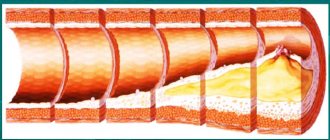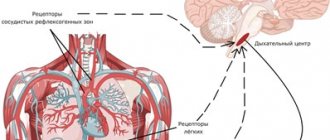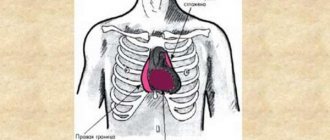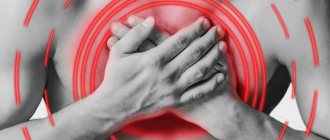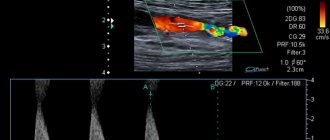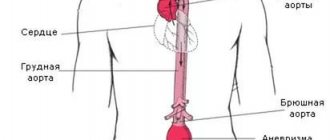Peripheral artery disease develops due to impaired circulation in the arteries of the lower extremities, as a rule, this happens due to atherosclerosis. This is explained by the fact that insufficient oxygen penetrates into the tissues.
The likelihood of developing vascular disease increases with age. About 30% of older people over 70 years of age suffer from it. The risk of pathology increases in people with diabetes and smokers.
So, what kind of disease is this, what are the reasons for its development, what symptoms are observed? How do doctors diagnose peripheral artery disease and is it treatable? What preventive measures exist today?
Features of leg artery disease
Blood, saturated with oxygen and nutrients, moves through the arteries from the heart to the organs and tissues of the body. If blood flow in the arteries of the legs is disrupted, then their tissues receive insufficient amounts of nutrients and oxygen, resulting in peripheral artery disease.
Blood flow in the aortas is disrupted as a result of the development of atherosclerosis. The aorta itself is a large vessel from which branches depart that supply blood to the head, upper limbs, neck, abdominal organs, chest organs, pelvic cavity, after which the artery divides into two branches through which blood flows to the legs.
In normal condition, the surface of the inner side of the vessel is smooth, but in old age, atherosclerosis of the peripheral arteries develops, in which lipid plaques are deposited in the vessel wall. This leads to disruption of the structure of the walls of the arteries, narrowing, compaction and, as a result, disruption of blood flow in it. Lipid plaques are composed of calcium and cholesterol. As atherosclerosis progresses, the lumen in the aorta becomes narrower and leads to the appearance of the first signs of arterial disease. This disease may not manifest itself at all for a long time, while atherosclerosis of the peripheral arteries will continue to progress and, in the absence of timely diagnosis and proper treatment, can lead to limb amputation. In addition, the risk of developing blood supply disorders in other organs increases, which can provoke myocardial infarction or stroke.
The main manifestation of peripheral artery disease is a feeling of severe discomfort or pain in the legs when walking. The localization of pain is different, the place of its occurrence depends on which parts of the arteries were damaged. Pain can occur in the foot, knees, lower back, hip, and legs.
Reasons for the development of the disease
Peripheral vascular disease is usually caused by atherosclerosis, in which fatty deposits (plaques) form on the walls of the arteries and obstruct the flow of blood.
Although atherosclerosis is usually referred to as damage to the arteries of the heart, this disease can and usually does affect the arteries of the entire body. If circulatory disturbance occurs in the arteries of the extremities, then peripheral vascular disease occurs.
Other causes of the disease may be inflammation of the blood vessels, injuries to the limbs, anatomical features of the structure of ligaments and muscles, or radiation.
Causes of disease of the arteries of the lower extremities
So, the main cause of the development of pathology of peripheral arteries is atherosclerosis. Moreover, men are more susceptible to the disease than women. There are many factors that increase the risk of developing this disease, the main ones are:
- Diabetes.
- Long-term smoking.
- Constantly high blood pressure.
- Increased amount of cholesterol in the blood.
- Obesity.
A high risk of developing this disease occurs in people who have previously encountered problems with the cardiovascular system.
Why does it occur
The aorta is a large artery divided into two parts that supplies blood to the lower extremities.
If a person has diseases of the peripheral veins, the walls of the aorta and its branches begin to become overgrown with lipid plaques. This process is accompanied by a narrowing of the lumen of the vessels, that is, their partial blockage. As a result, the lower limbs cannot receive enough blood. The main cause of peripheral arterial disease is atherosclerosis. It develops gradually and causes the formation of atherosclerotic plaques on the walls of blood vessels. These tumors begin to obstruct blood flow, causing peripheral vascular disease to occur.
In addition, the reasons for the development of such diseases may be:
- Maintaining a sedentary lifestyle. Due to a lack of physical activity, stagnation processes begin to occur in the human body, which lead to a deterioration in the blood supply to internal organs and parts of the body.
- Inflammatory processes in the body. Their presence can provoke a narrowing of the lumen of blood vessels and weakening of their walls.
- Diabetes. Leads to an increase in the level of glucose in the blood, which, in turn, causes damage to the walls of blood vessels. Also, the progression of the disease is accompanied by an increase in blood pressure, which contributes to the development of atherosclerosis.
- Blood clots. They are blood clots that form on the walls of blood vessels. Over time, they can break off and partially or completely block blood flow.
- Some diseases of the autoimmune system. Against the background of their development, damage to small blood vessels occurs, which contributes to disruption of the functioning of internal organs and their tissues.
- Arterial injuries. They also lead to poor blood flow. Peripheral veins can be damaged by accidents such as falls from a great height or car accidents.
- Infectious vascular pathologies. They develop with the uncontrolled proliferation of bacterial microflora and provoke a narrowing of the lumen of veins and arteries.
- Anomalies in the development of vascular structure. They are birth defects that cause various circulatory problems.
Also, disorders of the vascular system can develop if a person has:
- hereditary predisposition;
- obesity of any degree;
- persistent increase in blood pressure;
- high levels of cholesterol in the blood;
- nicotine addiction.
Symptoms and treatment
Atherosclerosis of the vessels of the lower extremities is the main cause of the development of disease of the arteries of the legs, the most common symptom of which is pain while walking. Painful sensations can occur on any part of the legs; the location of the pain depends on where the affected vessels are located.
Painful sensations arise due to insufficient blood supply to tissues, that is, due to such an ailment as atherosclerosis of the vessels of the lower extremities, the symptoms and treatment of which are interrelated. Therapy must be started as early as possible, otherwise its progression can lead to complete blockage of the artery and, as a consequence, amputation of the limb.
But the symptoms of the disease do not always manifest themselves clearly; often the doctor does not even suspect that the patient is developing a pathology. Often treatment begins only after symptoms become pronounced. If the disease is not treated in time, it can cause a heart attack or stroke.
Another striking symptom of vascular disease in the legs is lameness. At rest there is no pain and occurs only while walking. It should be borne in mind that lameness and pain are not mandatory symptoms, they can occur in rare and exceptional cases, for example during long walks or while climbing a mountain. But over time, the clinical manifestations of the disease do not disappear, but on the contrary, they intensify, convulsions occur, a feeling of heaviness that does not go away even after rest, a feeling of squeezing. If all these symptoms occur, you should seek medical help.
There are a number of indirect signs that indicate the development of peripheral artery disease:
- Hair loss.
- Pale and dry skin on the legs.
- Decreased sensitivity in the lower extremities.
The degree of development of the disease is determined by the intensity of the symptoms; the stronger the pain and discomfort while walking, the more serious the disease. If the disease is advanced, pain bothers the person even at rest.
Obliterating atherosclerosis
Peripheral artery disease (PAD) in most cases is caused by atherosclerosis, another systemic disease characterized by abnormalities in the structure of the artery walls. Atherosclerotic plaques form in the lumen of the vessels, leading to the settling of blood clots, narrowing of the arterial lumen and the appearance of areas of thrombosis. As a result, the trophism of the tissues surrounding the affected vessels is disrupted, they begin to suffer from ischemia (insufficient blood flow) and the patient develops obliterating atherosclerosis.
Thrombosis usually affects the vessels of the lower extremities at the level of:
- abdominal aorta (Leriche syndrome) – the infrarenal section of the abdominal aorta narrows and blood circulation is impaired in both legs;
- pelvis – the iliac artery is affected;
- hips – the lumen of the femoral artery is blocked;
- shins – blood clots settle in the arteries of the legs and feet.
With significant narrowing of the peripheral arteries of the legs, tissue trophism can be so disrupted that the patient develops trophic ulcers due to constant ischemia and gangrene can develop, leading to the need for amputation of the leg. In addition, atherosclerosis is prone to progression and the patient’s risk of developing myocardial infarction and stroke increases in the future, since both the coronary and carotid arteries are involved in the pathological process.
The process of occurrence and spread of atherosclerotic plaques occurs unnoticed in almost 50% of patients. Often, patients with such pathologies consult a doctor only when conservative treatment methods are not enough to restore blood flow and there is a need for surgical correction of the affected arteries.
The causes of PAD are the same as the factors that provoke the development of atherosclerosis:
- *imbalance in lipoproteins and accumulation of cholesterol in vascular walls;
- autoimmune pathologies accompanied by infiltration of vessel walls with leukocytes and macrophages;
- congenital defects in the structure of blood vessels;
- hormonal imbalances of adrenocorticotropic and gonadotropic hormones, leading to increased cholesterol levels in the blood;
- failures in antioxidant systems;
- brought infections.
*Elevated is considered to be a total cholesterol level of more than 8 mmol/l, an HDL level in men of less than 1 mmol/l and in women less than 1.3 mmol/l, an LDL level of more than 6 mmol/l, and a triglyceride level of more than 1.7 mmol/l.
All these reasons can trigger the process of formation of atherosclerotic deposits, but the leading role in damage to peripheral arteries lies in lipid balance disorders. According to statistics, men over 40–45 years of age are more likely to encounter such pathologies.
The following controllable and uncontrollable factors can predispose to the development of atherosclerotic lesions of the arteries:
- age (for women after 55 years and men after 45 years);
- smoking;
- postmenopausal period;
- excess weight and waist circumference in women is more than 88 cm, and in men more than 100 cm;
- arterial hypertension more than 180/110 mm Hg. Art.;
- diabetes;
- hypothyroidism;
- hereditary disorders (coagulopathies, homocystinuria);
- hereditary predisposition to vascular and heart diseases;
- congenital vascular anomalies;
- adynamia;
- taking a large amount of fast food, fatty, fried, flour, sweets, baked goods, carbonated drinks;
- taking medications that increase blood cholesterol levels;
- taking hormonal contraceptives;
- disorders in the blood coagulation system, accompanied by increased thrombus formation;
- frequent stress;
- chronic sleep deficiency.
Uncontrollable factors cannot be eliminated. They contribute to the formation of atherosclerotic plaques, but in the absence of controlled conditions are not capable of causing obliterating atherosclerosis.
With the development of atherosclerosis, the following occurs:
- on the inner wall of the artery, a lipid stain is formed that transforms into liposclerosis, leading to the formation of unstable atherosclerotic plaques, which can still dissolve;
- fibrous plaques appear that can no longer resolve, and atheromatosis develops, accompanied by the disintegration of the contents of plaques, collagen and elastin in the vessels;
- when plaques disintegrate, the stage of complications of atherosclerosis begins: thrombosis, embolism, rupture of the aneurysm formed in the lumen of the artery;
- the formation of atherocalcinosis - this stage is accompanied by the deposition of calcium salts in the atherosclerotic plaque and severe ischemia of tissues and organs.
Symptoms of peripheral artery disease do not appear immediately, but only at the stage of severe ischemia of a particular area. Initially, the patient complains of pain, cramps and fatigue in the legs after walking or physical activity. The pain is usually located in the thighs, buttocks and feet. Sometimes patients may experience swelling. There is also no pulsation in the area of damage to the arterial vessel. The skin on the affected limb becomes paler and cooler to the touch at the level of the arterial lesions. Men may experience problems with potency due to impaired blood flow.
Somewhat later, the patient develops a symptom characteristic of obliterating atherosclerosis of the lower extremities, such as intermittent claudication (claudication) - pain and cramps in the calf muscles, aggravated by walking. It is provoked by a lack of oxygen, which is most pronounced during walking, and disappears after the person stops.
Intermittent claudication is most pronounced when climbing stairs. Initially, it occurs after walking long distances, and then, as atherosclerotic lesions of the arteries and ischemia progress, it appears even after covering very short distances. In the most advanced stages, it occurs even during rest. This condition is commonly called critical ischemia.
The stages of PAD are:
- I – symptoms of thrombosis and narrowing of the arteries are not felt;
- IIa – pain and intermittent claudication occur after covering more than 200 m;
- IIb – pain and lameness occur when covering less than 200 m;
- III – pain and intermittent claudication occur at rest;
- IV – due to ischemia, ulcers and wounds occur due to tissue necrosis.
The progression of PAD is indicated by the following manifestations:
- increased pain syndrome;
- sensory disturbances and coldness of the limb;
- dry skin and the appearance of cracks prone to infection;
- the occurrence of ulcers and wounds on the feet, legs or toes.
When PAD is complicated, it leads to the development of gangrene and the need for urgent surgery to amputate the limb.
Severe narrowing of the arteries of the lower extremities
When the arteries are severely narrowed due to lipid plaques or are completely blocked (peripheral artery thrombosis), pain in the legs appears even during a period of rest. The legs may appear completely normal, but the toes are pale in color, sometimes with a bluish tint. They are usually cold to the touch and have weak or absent impulses.
In the most severe cases of oxygen deficiency, tissue necrosis (death) begins. The lower part of the leg (ankle) becomes covered with trophic ulcers; in the most advanced cases, gangrene develops, but such a complication is rare.
Occlusive disease of the arteries of the lower extremities
Peripheral arterial occlusive disease is a common manifestation of atherosclerosis. This disease leads to limited ability to move, often to death.
The term “occlusive arterial disease” refers to damage not only to the arteries of the legs, but also to other vessels that pass through the brain and internal organs, that is, it is a disease of peripheral arteries and veins.
With age, the risk of developing the disease increases.
People at risk include:
- under 50 years of age, who have an increased risk of developing atherosclerosis;
- from 50 to 70 years – smokers or people with diabetes;
- over 70 years old;
- with characteristic atherosclerotic symptoms in the lower extremities.
Poor circulation in blood vessels can occur due to damage or thrombosis.
First aid for the development of a blockage of a vessel is as follows: it is necessary to give the person painkillers and cardiovascular medications, cover the limbs with ice, bandage them if necessary, and send the person to the hospital.
Treatment of thrombosis is usually conservative. But such measures are used if no more than 6 hours have passed since the attack.
Surgical treatment - artery plastic surgery, bypass surgery or vascular replacement.
Causes of vascular disease
There are many reasons that lead to the development of vascular diseases. The most common pathological factors are:
- infectious inflammation (thrombophlebitis, arteritis),
- congenital defects and pathologies of the cardiovascular system (high tortuosity of the spinal artery, pulmonary stenosis),
- accumulation of plaques on the inner arterial lining,
- clogged blood vessels (emboli and thrombi),
- violation of the elasticity and strength of the vascular wall (aneurysms, varicose veins),
- autoimmune processes in the body (endarteritis obliterans),
- destruction of the vascular membranes, which leads to their rupture with subsequent outpouring of blood into the internal environment of the body,
- hypothermia, characterized by narrowing of the lumen of blood vessels.
- too high or too low vascular tone.
In addition, there are a number of diseases against which pathological processes in the veins and arteries can develop. These include:
- diabetes,
- blood diseases,
- low content of vitamins in the body,
- widespread type of atherosclerosis,
- dysfunction of the central nervous system,
- infectious diseases,
- heart failure,
- genetic diseases that are inherited.
An important cause of human vascular insufficiency is disturbances in the vasomotor center. To cure this disease, you should consider what exactly caused the disease
These lesions are classified according to the classification into diseases of central and peripheral blood vessels.
Obliterative arterial disease
Obliterating disease of the peripheral arteries is a dangerous and severe chronic pathology characterized by a progressive course. Manifests itself in the form of chronic ischemia of internal organs and limbs. With this disease, there is a disruption in the flow of arterial blood to the lower extremities, this is due to a violation of the elasticity of the blood vessels. Blood circulation does not occur in the required volume, narrowing of the arteries occurs, and sometimes their complete closure.
Risk factors for developing this disease include: high blood pressure, diabetes, smoking, high blood fats, and a sedentary lifestyle.
The first sign of the development of pathology is pain in the lower leg, calf muscle, and buttock. Gradually, the pain begins to intensify, it becomes difficult for the person to move long distances, and eventually he stops walking altogether.
Treatment of pathology is aimed at restoring natural blood circulation in the affected area. As a rule, anti-inflammatory drugs are prescribed; in later stages, surgery is prescribed, the purpose of which is to restore impaired blood flow.
If gangrene develops, amputation of the limb will be required.
Thrombosis
The disease is associated with the formation of a clot or thrombus in the lumen of a vessel, which causes an inflammatory process and disruption of normal blood flow in this area.
Another name for the disease is associated with inflammatory changes - thrombophlebitis, phlebothrombosis.
| Characteristics of the pathology | Description |
| Occurrence | 27–30 % |
| Causes | Long period without active walking Congenital structural features of the vein wall Changes in the blood coagulation system Injuries and infections |
| Symptoms | Pain syndrome of varying severity Swelling of part of the limb Heaviness in the arm, leg Skin changes: redness, ulceration, tissue death |
| Treatment | Drug therapy:
Surgical methods of treatment:
|
| Forecast | There is no complete cure |
A pathological condition that develops as a complication after thrombosis and thrombophlebitis. It is associated with a violation of the structure of the walls of the veins and leads to chronic disruption of the outflow of venous blood.
| Characteristics of the pathology | Description |
| Occurrence | 28 % |
| Causes | Vein thrombosis |
| Symptoms | Leg pain Edema of varying severity Ulceration of the skin on the legs Inability to stand for long periods of time Cramps in the limbs Severe itching of the skin Changes in saphenous veins, their deformation |
| Treatment | Drug therapy:
Surgical methods of treatment:
|
| Forecast | There is no complete cure |
The formation of intravital blood clots (thrombi) in vessels can occur as a protective reaction to bleeding (normal) or be a consequence of pathological changes in the arteries and veins. Thrombosis leads to hemodynamic disturbances due to stenosis (narrowing of the lumen) and occlusion (blockage) of blood vessels.
Thrombosis leads to hemodynamic disturbances and blockage (occlusion) of blood vessels
Thrombophlebitis and phlebothrombosis - intravital blood coagulation in venous vessels - develops as a result of inflammation of the vessel wall with the launch of the coagulation cascade. Superficial vein thrombosis often develops against the background of varicose veins (blood stasis).
Damage to the endothelium is caused by infectious agents, allergic reactions, tumors, and injuries. In turn, blood clots further injure the walls of blood vessels and the valve apparatus. Deep vein thrombosis (phlebothrombosis) is complicated by embolism with occlusion of pulmonary vessels. Large emboli are fatal.
Risk factors for these pathologies are:
- obesity;
- long-term operations in the abdominal cavity, joints of the lower extremities;
- physical inactivity;
- pregnancy and childbirth, when the concentration of blood clotting factors increases, blood flow in the pelvic vessels is disrupted;
- taking contraceptives;
- tumors;
- smoking.
Patients complain of pain (spreading along the vein or appearing with movement, compression), compaction along the vein, swelling, a feeling of heat and heaviness in the limb. In 70% of cases, swelling and pastiness indicate vein thrombosis. If pulmonary embolism has developed, the symptoms are complemented by pain in the chest area.
The photo shows a manifestation of venous thrombosis of the lower extremities
Diagnosis of vein thrombosis, in addition to studying the clinical picture and ECG, includes a blood test (with determination of the number of platelets and hematocrit), a coagulogram (diagnosis of hemostasis), color duplex ultrasound, venography (relevant for floating blood clots), MRI (for visualization of blood clots) and angiography (for visualization blood vessels), scintigraphy (in complex cases), plethysmography; phlebotonometry (to analyze the operation of valves).
Treatment methods
Therapeutic measures require:
- preventing the progression of thrombosis (anticoagulant agents);
- thrombolysis to eliminate existing blood clots;
- improving the outflow of blood and lymph (postural drainage, compression);
- improving microcirculation, correcting rheological blood parameters, increasing venous tone (antiplatelet drugs);
- relief of inflammation.
Surgical methods are aimed at removing thrombotic mass and damaged vein (thrombectomy), preventing thromboembolism (installation of a vena cava filter).
Prevention of thrombosis includes compression therapy, physical therapy, and timely removal of pathological veins.
Arterial thrombosis is a consequence of:
- obliterating arteriosclerosis;
- arterial aneurysms;
- collagen vascular pathologies;
- myeloproliferative disorders;
- DIC syndrome (disseminated intravascular coagulation);
- dysproteinemia.
Most often, thrombus formation in the artery is a complication of atherosclerosis. In addition, blood clots form in the atria during fibrillation, and in the ventricles (after myocardial infarction).
Arterial occlusion causes symptoms, depending on the location of the artery and the degree of hemodynamic disturbance: ischemic pain, change in skin tone (pallor, cyanosis, marbling), decreased sensitivity. Acute hypoxia of the brain and myocardium is a deadly consequence of arterial thrombosis.
In the treatment of arterial thrombosis, conservative methods (anticoagulants) and surgical ones (bypass surgery, thrombolysis, angioplasty) are used.
Diagnosis of the disease
The doctor interviews the patient, measures blood pressure, asks about bad habits and lifestyle. After which he feels the pulse in the artery, in the damaged area.
For an accurate diagnosis, the doctor prescribes special tests to determine whether the arteries of the extremities are affected or not. One way to study peripheral arteries is to measure blood pressure in the leg and arm and compare the results. This will allow us to make an assumption about the development or absence of vascular pathology. In some cases, the doctor prescribes an ultrasound of the lower extremities to examine the peripheral arteries; this will provide complete information about the blood circulation in the affected area.
If the doctor still has doubts after the procedures performed, he prescribes angiography (X-ray examination of blood vessels) and tomography (examination of the condition and structure). If there is a suspicion that the patient has a late stage of development of the disease, he is prescribed radiography.
Treatment methods for peripheral arteries
The treatment method depends on the degree of development of the disease, as well as on the affected area. The main goal of treatment is to stop the progression of the disease and minimize the risk of complications.
The patient is prescribed a course of treatment, in addition, he is advised to eat right, change his lifestyle, and give up alcohol and smoking. All bad habits negatively affect human blood vessels.
If treatment of peripheral arterial lesions is started earlier, the course of treatment will be compliance with preventive measures.
Medicines prescribed are those aimed at regulating cholesterol levels. Sometimes the course of treatment includes drugs that reduce the effect of platelets. These medications are aimed at thinning the blood, which is a good prevention of blood clots.
Conservative treatment is used if the disease is mild. In case of severe damage to the peripheral arteries, surgical treatment is necessary.
If large arteries are damaged, a surgical procedure is used - angioplasty. A flexible catheter is inserted into the arterial lumen through the femoral vein, then a conductor is inserted, which delivers a special balloon to the place where the vessel is narrowed. By inflating this balloon, the normal lumen of the vessel is mechanically restored.
In more advanced cases, arterial bypass surgery is performed. An additional vessel is created through which blood flow is allowed, bypassing the affected area. For this purpose, both artificial prosthetic vessels and the patient’s own veins are used.
Sometimes surgical removal of atherosclerotic plaque is used. To do this, the artery is opened, but this procedure can disrupt blood flow through the vessel.
The most radical surgical treatment method is amputation of the limb; this method is used only in case of gangrene development.
METHODS FOR DIAGNOSIS OF PERIPHERAL VASCULAR DISEASE
The severity of signs of peripheral vascular disease depends on the degree of disruption of blood flow in them.
The most common symptom is the presence of pain in the problem area. Muscle tissues in the area of the buttocks, thighs, and legs are often affected. Uncomfortable sensations appear during increased physical activity and walking, which force the patient to interrupt activity or movement.
Other symptoms of peripheral vascular disease include:
- increased dry skin on the lower extremities;
- weakness in the legs;
- the presence of a feeling of numbness and tingling in them;
- the presence of areas of the dermis with missing hair;
- increased fatigue;
- pale or bluish skin tone on the legs;
- the appearance of edema;
- convulsions;
- atrophic changes in the muscles of the lower extremities.
If you have several of the listed signs, you should definitely consult a specialist.
At the initial visit, a visual examination is performed and an anamnesis is collected. The doctor pays attention to the structure and color of the skin, palpates problem areas, measures blood pressure, and identifies diseases that preceded the development of vascular pathology.
Instrumental diagnostics are prescribed, which involves:
- ultrasound examination identifying the affected areas of the arteries;
- electrocardiogram;
- angiography showing where the blood vessels are narrowing;
- Ultrasound and Doppler analysis of arteries in the cervical region;
- establishing blood pressure data in the lower extremities and comparing them with values in the arms.
A general blood test and blood test for cholesterol and glucose levels are prescribed.
In many cases, peripheral vascular disease is asymptomatic or with mild symptoms. The main manifestation is pain in the legs while walking, which in some cases leads to the appearance of intermittent claudication. With a dynamic circulatory disorder, there is pain in the leg muscles or cramps in the legs or arms, which appear with exertion, for example, while walking, and disappear in within a few minutes of rest. The location of the pain depends on the location of the blocked or narrowed artery. The calves are the most common location.
The intensity of symptoms can vary - from mild discomfort to debilitating pain. With severe pain, it becomes difficult for patients to walk and do other physical work.
Symptoms of peripheral vascular disease are:
- Painful cramps in the muscles of the buttocks, thighs, calves after physical activity, such as walking or walking up stairs (dynamic circulatory disorder / intermittent claudication)
- Leg muscle weakness and numbness
- Continuous pain in your toes, feet, or legs
- Change in skin color of the legs
- Hair loss or slow hair growth on the legs
- Slow growth of toenails
- Shiny skin on feet
- Weak or absent pulse in the veins of the lower extremities
- Erectile dysfunction in men.
As the disease progresses, the pain does not go away even at rest and lying down (ischemic pain at rest). The pain can be extremely excruciating and deprive a person of sleep. Temporary relief may come from hanging your leg over the edge of the bed or walking around the room.
- History taking and physical examination. Diagnosis of peripheral vascular disease is based on symptoms and the results of a medical examination.
- Presence of risk factors for peripheral vascular disease, in particular smoking and diabetes
- Presence of symptoms, particularly those that occur with walking, exercise, sitting, lying down, standing, and upward movement
- Nutritional Features
- Taking medications, including prescription and over-the-counter medications
- Cases of heart and blood vessel disease in the family.
- Ankle-brachial index (ABI). This method, which compares blood pressure in the ankle and arm, is usually used to diagnose peripheral vascular disease.
- Ultrasound examination. Special ultrasound imaging methods, for example, Doppler ultrasound of the arteries of the extremities, make it possible to identify organic and functional circulatory disorders and detect the presence of stenosis (blockages) of the arteries and thrombosis.
- Angiography. During this procedure, a liquid contrast agent is injected into the blood vessels using a long, thin tube (catheter). Modern imaging methods - fluoroscopy, magnetic resonance imaging or computed tomography - make it possible to monitor the distribution of the contrast agent in the vessels.
- Blood analysis. A laboratory blood test determines the concentration of cholesterol and triglycerides, and can also detect the presence of diabetes.
During the initial examination, the doctor pays special attention to the patient’s lifestyle, (bad) habits, family diseases, as well as:
The physical examination considers the presence of signs of peripheral vascular disease. The pulsation of the arteries in the legs and feet is assessed; for example, the pulse in the artery below the blockage may be weak or completely absent.
In addition, a stethoscope is used to listen for abnormal sounds in the arteries of the legs, which are called vascular murmurs. Vascular murmurs occur due to the turbulent flow of blood created through a narrowed or blocked artery.
During the examination, blood pressure in the lower extremities is also determined and compared. In the affected leg, pressure readings are often significantly lower than normal. The disease may be indicated by poor wound healing, which is observed in the place where blood flow is limited, changes in the hairline, and the condition of the skin and nails.
To determine the ABI, a special ultrasound device is used that records pressure readings in the ankle and arm areas. After comparing these readings, the pressure and efficiency of blood flow are determined.
To determine the severity of the disease and the degree of vasoconstriction, the indicators obtained while the patient is at rest and while walking on a simulator are compared.
Catheterization angiography, compared to other diagnostic methods, is a more invasive procedure during which a contrast agent is injected into an artery in the groin area using a catheter. However, it allows you to simultaneously diagnose - find damaged vessels, and carry out treatment - expand or administer drugs to improve blood flow.
Disease prevention
There are a number of preventive measures that will reduce the risk of progression of arterial disease:
- The best prevention of the development of arterial pathology is an active lifestyle.
- Proper and balanced nutrition will provide the human body with minerals and trace elements, the lack of which can provoke the development of vascular disease.
- Constant monitoring of blood cholesterol levels.
- Taking medications for high blood pressure.
- Excluding spicy and fatty foods from the menu.
- Animal fat should be completely replaced with vegetable fat.
- Monitor your blood sugar readings.
- Quitting smoking and alcohol.
- Watch your weight.
- Taking aspirin to prevent blood clots.
- Hiking in comfortable shoes.


